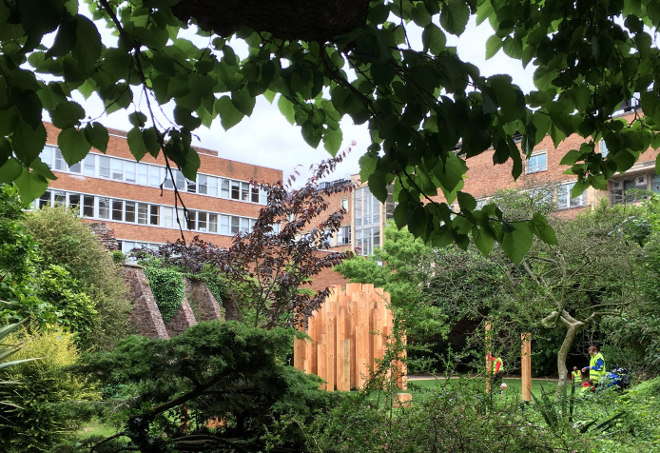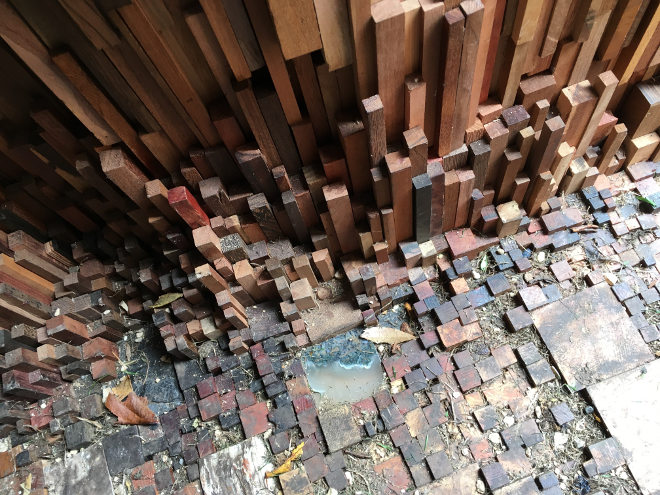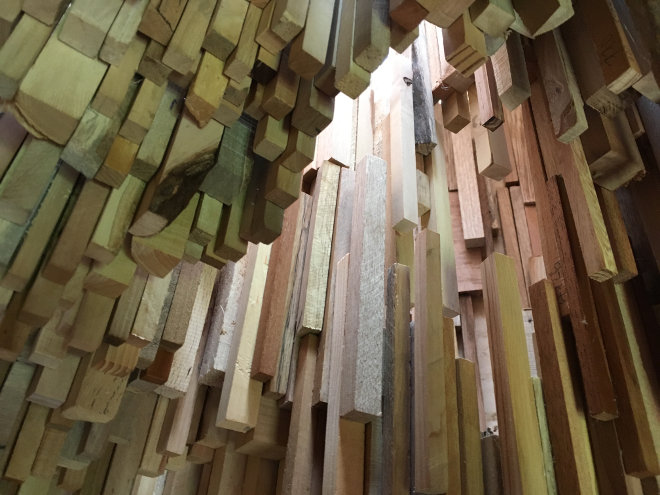 Funny how big things sometimes seems small, and sprawling things can feel contained. Nestled in a corner of the University of Bristol’s elegant Royal Fort Gardens, you’ll find a neat gathering comprised of ten thousand trees, stretching quietly skywards.
Funny how big things sometimes seems small, and sprawling things can feel contained. Nestled in a corner of the University of Bristol’s elegant Royal Fort Gardens, you’ll find a neat gathering comprised of ten thousand trees, stretching quietly skywards.
This is not how forests behave. Forests breathe and whisper, they spread and grown, they exhale fragrances of leaf mould, animal matter, the evidence of countless tiny lives.
This is not a forest, or even a copse, but a grotto, built from slim rectangular shards cut and smoothed from 10,000 species of tree. The colours waver from straw yellow to a rich henna hue. The wood here is organised, arranged, collected. Step inside, close your eyes and inhale the subtle sunlit woody smells, surrounded by straight-edged shapes arranged in an orderly fashion entirely at odds with any living wood you’ve ever entered. But perhaps that’s the point.
This is the creation of Katie Paterson, who spent three years collecting the samples from forests, arboretums and private collections across the world. She’s an artist of extraordinary scope, having previous created a candle that recreates the smell of travelling through space, and a library in the form of a seedling forest that will be eventually be transformed into books no one currently alive will ever read.
In Hollow, Katie says she has tried to mimic the impression of being in a forest with light falling through trees – with carefully placed apertures allowing sunlight to stream inwards.
Except, in a forest, the light moves, as branches quiver and shift with the wind. A forest is never still, never silent, while in Hollow everything is frozen and soundless.
For me, that was a profound and moving difference. There is a moment of wonder as you enter and encounter so many pieces of so many trees, but you need to remind yourself that this is what they are – that over here may be a a sample from the Japanese Ginkgo tree in Hiroshima, and over here a piece from the tallest fir tree in Britain, the mightiest conifer in Europe – trees from different continents and eras.
Hollow is not a forest, and nor does it claim to be. It is a human appropriation of the concept of the world’s trees – an orderliness imposed on something that should, by nature, be disorderly. It represents, I think, the tendency of humans to seek structure where none should be. Do visit it and step inside, take a moment to inhale and think, marvel that so many trees can make up such a small space, then remerge into the gardens where living trees move and breathe.
Hollow is a beautiful accomplishment, and an incredible collection, but in truth, its name tells you everything you need to know.
Are you an artist or do you know an artist who would like to be showcased on SkyLightRain.com? Get in touch at judydarley (at) iCloud.com. I’m also happy to receive reviews of books, exhibitions, theatre and film. To submit or suggest a review, please send an email to judydarley (at) iCloud.com.


